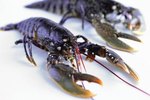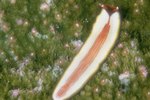
Worms are invertebrates with long, soft bodies and no hard skeleton. Their shapes are varied, and they range in size from microscopic to 75 feet in length. Scientists have classified worms into more than 15 phyla. The phylum Annelida contains the segmented worms. Annelida is further divided into three subclasses: Oligochaeta, Hirudinea and Polychaeta. Thousands of species of segmented worms comprise these three subclasses.
Segmentation Basics
All species contained in the Annelida phylum are segmented to varying degrees. The transecting segments divide their bodies into subdivisions. Each subdivision houses the organs for specific bodily functions such as the circulatory, nervous or digestive systems. Segmentation, also called metamerism, localizes muscle contraction, allowing body movement to attain ultimate proficiency. Hydrostatic pressure across each segment permits the annelid's bodies to bend and contract without collapsing.
Subclass Oligochaeta
Oligochaeta is composed of earthworms and related species. Earthworms have smooth, mucous-coated skin, usually in hues of gray, white, pink or reddish-brown. Their bodies exhibit distinct segmentation. Each segment is covered with stiff, microscopic hairs that enable movement. They vary in size from less than one inch to more than six feet long. Most species are hermaphroditic. Hundreds of species inhabit moist soil environments on every continent, feasting on decaying plant material and roots. Blind and deaf, they communicate through touch and taste, and are able to sense light and vibrations.
Subclass Hirudinea
Hundreds of species of leeches comprise Hirudinea. Leeches have flat, dark-colored bodies with suction cups at each end. Some species have one or more pairs of eyes, and many possess sharp teeth or strong, crushing jaws. These hermaphroditic worms range from less than one inch to almost 10 inches in length. They inhabit freshwater, oceans and moist soil all over the world. Deaf and poorly sighted, they hunt and communicate using profoundly heightened senses of touch and taste. Infamous as parasitic blood-suckers, many leeches feed on fish, waterfowl, turtles or other vertebrates. However, not all leeches feed on blood. They are predators that consume worms, snails, fish and other invertebrates.
Subclass Polychaeta
According to the Smithsonian National Museum of Natural History Department of Invertebrate Zoology, Polychaeta is the largest Annelida subclass. It's divided into 13 families that include, among others, fireworms, fan worms, rag worms, paddle worms, spaghetti worms and bamboo worms. They're primarily marine species, inhabiting oceans all over the world. Like their Annelida counterparts, their segmented bodies house their circulatory, digestive and nervous systems. However, in contrast to other annelids, they possess well-developed heads, eyes, appendages and sense organs. They further differ from other annelids in that they do not mate. Fertilization is external, meaning eggs and sperm are released into the water and unite independently of the originating organisms.
References
Resources
Photo Credits
-
Ryan McVay/Photodisc/Getty Images
Writer Bio
Yvette Sajem has been a professional writer since 1995. Her work includes greeting cards and two children's books. A lifelong animal advocate, she is active in animal rescue and transport, and is particularly partial to senior and special needs animals.



